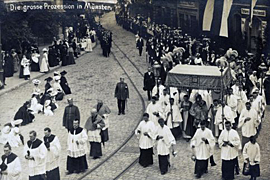(B4) Blessings for the Mighty: Legitimacy and Legitimation of Political Rulership in Late Medieval and Modern City Processions

The fact that rogation, Corpus Christi and saints’ processions procured God’s blessing or the help of the saints for councillors, princes and statesmen, is part of the general knowledge of historical research. Members of the urban and national leadership elites situated themselves near the altar sacraments and, dressed in ceremonial clothing, carried the baldachin, images and the reliquary casket. Period-specific case studies thematise the reflection of late medieval urban society (Löther, Trexler), the relative importance of processions in the Reformation (Scribner), the enforcement of the early modern confessional state (Châtellier, Freitag), the preservation of Catholic identity during the Kulturkampf, and the resistance against the inhuman National Socialist ideology that was given expression in the form of processions (Freitag, Stambolis).
In accordance with the considerations of the cluster of excellence, these isolated approaches will be abandoned in order to show longitudinally how political order was created in religious rituals and how, through the aura of the divine, urban representatives laid claim to legitimacy and won it in the eyes of the faithful, even in competition with national rulers. The period under consideration extends from the late Middle Ages into World War I.
During the practical project work, however, it became apparent that the explanandum of “legitimacy of rule” leads to a convergence: meanwhile, project B4 pursues a more open concept under the superordinate concept of “order”. This means to trace the staging and (performative) foundation or ritualised reflection, respectively, of the city’s community, its political and social hierarchies and identities; so to investigate the constitutional reality and the role of the potentates as reflected in the processions, but also to conceive to a better degree the inclusion and exclusion in the ritual. In doing so, the following considerations and categories will be taken into consideration: processions set saintliness in motion; as ritual actions, they have an integrative function in Durkheim’s terms. At the same time, particularly in times of radical change, processions are ritual actions that performatively express new orders and may confirm them. Therefore, the project takes a closer look at the role of the actors, at the liturgical and secular sequences of the action, at the seeking and constructing of tradition, and at sacralisation strategies.
Cooperation with the Institute of Comparative Urban History
Study group Urban and Community Studies

